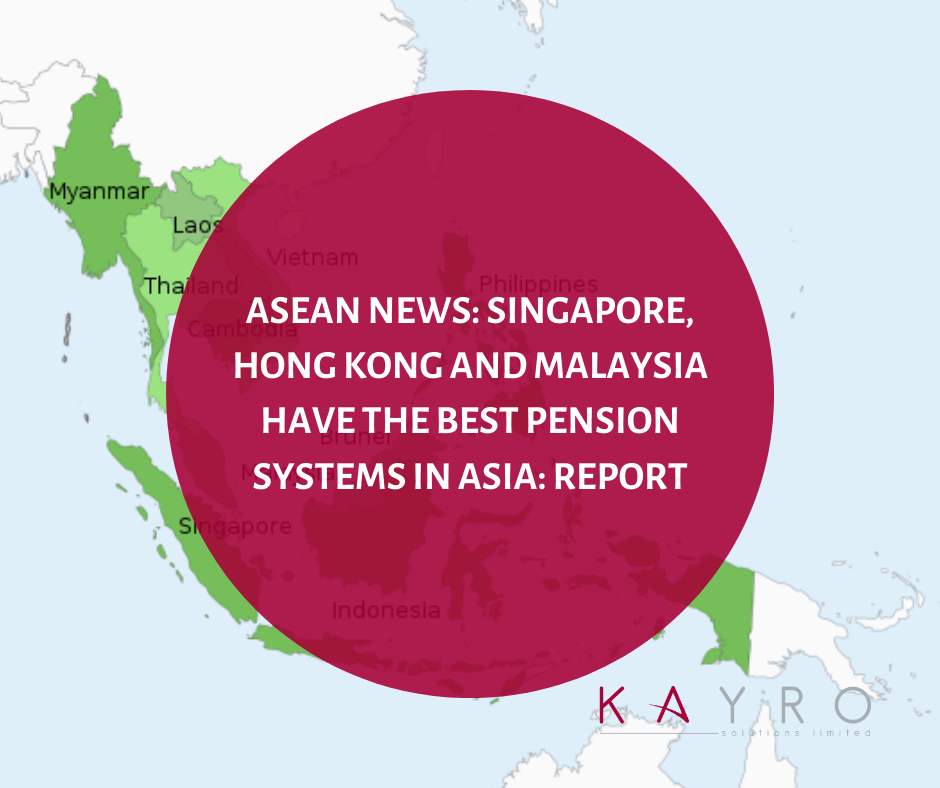Published in ASEAN News on
ASEAN News: Singapore, Hong Kong and Malaysia have the best pension systems in Asia: Report
They are followed by China, Taiwan, Indonesia, India, the Philippines and Thailand. However, looking at the global ranking, the top three countries with the best pension systems are: Iceland, the Netherlands and Denmark.

According to the Mercer Global Pension Index Report, Singapore's pension system is the best in Asia and ranks 10th in the world, tied with Finland, the United Kingdom and Sweden. After Singapore, Hong Kong and Malaysia are ranked 18th and 23rd respectively. Other Asian countries are ranked as follows:
28th place - China;
34th place - Taiwan;
35th place - Indonesia;
40th place - India;
41st place - Philippines; and
43rd place - Thailand
The three countries with the best pension systems are Iceland, the Netherlands and Denmark, each described as having "first-class and robust pension systems that provide good benefits, are sustainable and have a high level of integrity".
To understand how these rankings are arrived at, each country's pension system has an overall index score calculated based on three indices: Adequacy (40% weighting), Sustainability (35%) and Integrity (25%). Adequacy takes into account factors such as benefits, system design and savings, while sustainability includes pension coverage, total assets and public debt, and integrity includes regulation, governance and protection.
In this context, the top three European countries have (A-grade) scores of 84.2, 83.5 and 82 respectively. Singapore, on the other hand, has a (B-grade) score of 70.7, which is considered "a system with a sound structure and many good features, but some areas for improvement that distinguish it from an A-grade system"; Hong Kong has (C+) 61.8, and Malaysia has (C) 59.6, which are described as "a system with some good features, but also major risks and/or deficiencies that should be addressed". Without these improvements, its effectiveness and/or long-term sustainability may be questioned."
Chong Chee Loong, Wealth Business Leader, Mercer, Singapore, commented on Singapore's pension system: "Singapore's pension system is one of the oldest and most developed national systems in Asia, and it is great to see the system once again at the top of the Asian rankings, which is a sign of a leading pension system in the region with strong integrity."
Commenting on the pension system in Asia Pacific, Mary Leung, CFA, Head, Advocacy, Asia Pacific, at CFA Institute, said, "Although Asia performed relatively well compared to most other regions during COVID-19, there is no market in Asia that is not in dire need of pension reforms. We are operating in an extremely challenging environment with historically low interest rates and, in some cases, negative yields that are significantly impacting returns. Policymakers and industry players must work together to take action to ensure the adequacy and sustainability of pension benefits.
Can we improve our pension system?
According to the report, the short answer is: yes. The long answer is: to achieve this, each country needs to look at how it can:
- Increase the share of employees (including atypical workers) and the self-employed in private pensions;
- raise the statutory retirement age and/or the retirement age over time to take account of increasing life expectancy;
- Promote higher labour force participation at older ages;
- Promote higher levels of private savings to reduce future dependence on the state pension;
- Reduce the phasing out of pension savings before retirement; and
- Improving the governance of private pension plans and introducing greater transparency to increase the confidence of plan members and the wider public.
Using this framework in each country, China may consider, for example, increasing the minimum level of support for the poorest people in old age, or introducing a requirement that a portion of supplementary pensions be used as a source of income. India could consider extending pension schemes for the unorganised working class or improve regulatory requirements for the private pension system.
As for Indonesia, the country may consider increasing workers' participation in occupational pension schemes, thereby increasing the level of contributions and assets, or raising the retirement age as life expectancy continues to rise. Thailand, meanwhile, can do the same as China.
If Singapore wants to improve its value, Chong suggests lowering the hurdles to setting up tax-approved occupational pension plans and opening up the Central Provident Fund (CPF) to more non-Singaporean workers, who currently make up a significant percentage of the labour force. "This can be complemented by raising the age at which CPF members can access their retirement savings, as well as increasing communication about the CPF among Singaporeans," he added.
For Malaysia, the government can look at how to increase household savings levels and reduce household debt, while for Hong Kong, for example, rules could be introduced to protect the pension interests of both parties in the event of divorce.
Gender gaps in pension outcomes
An interesting finding of the report is that all pension systems need to take a number of measures to reduce the gender pension gap. This is a multi-faceted problem related to employment, pension policy and socio-cultural aspects. For example, women have to take longer out of the labour force due to caring responsibilities, or there are eligibility restrictions in some pension schemes that require a minimum income or number of hours worked.
Janet Li, Mercer's Wealth Business Leader for Asia, said, "Addressing the gender pension gap needs to be driven by all stakeholders, from employers taking an active role in ensuring gender equality in pay to individuals taking initiatives to improve their financial literacy. Our study shows that failure to address the gender gap in retirement savings has long-term costs for businesses, particularly in their ability to attract and retain talent, and for society. We need to act now and urgently".

